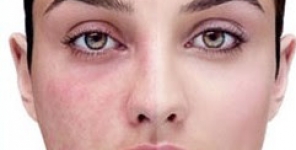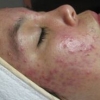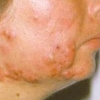Trattamento dell'acne per mezzo della terapia fotodinamica con metil aminolevulinato con luce rossa rispetto alla luce pulsata intensa
 Sono stati introdotti vari metodi della terapia fotodinamica (PDT) per l'acne. Tuttavia, per questi metodi sono ancora necessari ulteriori studi comparativi. Abbiamo eseguito questo studio per confrontare l'effetto della luce rossa rispetto alla luce pulsata intensa (IPL) in associazione alla PDT con metil aminolevulinato (MAL), nell'acne.
Sono stati introdotti vari metodi della terapia fotodinamica (PDT) per l'acne. Tuttavia, per questi metodi sono ancora necessari ulteriori studi comparativi. Abbiamo eseguito questo studio per confrontare l'effetto della luce rossa rispetto alla luce pulsata intensa (IPL) in associazione alla PDT con metil aminolevulinato (MAL), nell'acne.
In questo studio di 8 settimane, prospettico e a mezza faccia sono stati inclusi venti pazienti. Abbiamo applicato una crema di MAL su tutta la ficca con un tempo di incubazione di 3 ore. Poi i pazienti sono stati irradiati con una luce rossa di 22 J/cm2 su una metà della faccia e con 8-10 J/cm2 di IPL sull'altra metà, durante ciascuna sessione di trattamento. Abbiamo effettuato tre sessioni di trattamento ad intervalli di due settimane e abbiamo seguito i pazienti fino a quattro settimane dopo l'ultima sessione.
Le lesioni da acne, infiammatorie e non infiammatorie, sono state ridotte significativamente su entrambi i lati. Il lato trattato con luce rossa ha mostrato una migliore risposta rispetto al lato trattato con IPL, dopo il primo trattamento.
Non sono stati osservati gravi effetti collaterali, dopo il trattamento. MAL-PDT con luce rossa e IPL sono entrambe modalità efficaci e sicure nel trattamento dell'acne. La luce rossa ha mostrato un tempo di risposta più veloce rispetto ad IPL.
Dopo più sessioni, entrambe le fonti di luce hanno mostrato risultati soddisfacenti. Pensiamo che una riduzione della dose totale di luce rossa sia auspicabile quando si esegue MAL-PDT in pazienti asiatici affetti da acne, rispetto ai pazienti caucasici.
Storia della pubblicazione:
Titolo: Acne treatment by methyl aminolevulinate photodynamic therapy with red light vs. intense pulsed light
Rivista: International Journal of Dermatology. doi: 10.1111/j.1365-4632.2012.05673.x
Autori: Jong Soo Hong, Jae Yoon Jung, Ji Young Yoon, Dae Hun Suh
Affiliazioni: Department of Dermatology, Seoul National University College of Medicine
Acne Research Laboratory, Seoul National University Hospital, Seoul, Korea
Abstract:
Various methods of photodynamic therapy (PDT) for acne have been introduced. However, comparative studies among them are still needed. We performed this study to compare the effect of methyl aminolevulinate (MAL) PDT for acne between red light and intense pulsed light (IPL). Twenty patients were enrolled in this eight-week, prospective, split-face study. We applied MAL cream over the whole face with a three-hour incubation time. Then patients were irradiated with 22 J/cm2 of red light on one-half of the face and 8–10 J/cm2 of IPL on the other half during each treatment session. We performed three treatment sessions at two-week intervals and followed-up patients until four weeks after the last session. Inflammatory and non-inflammatory acne lesions were reduced significantly on both sides. The red light side showed a better response than the IPL side after the first treatment. Serious adverse effects after treatment were not observed. MAL-PDT with red light and IPL are both an effective and safe modality in acne treatment. Red light showed a faster response time than IPL. After multiple sessions, both light sources demonstrated satisfactory results. We suggest that reducing the total dose of red light is desirable when performing MAL-PDT in Asian patients with acne compared with Caucasians.





